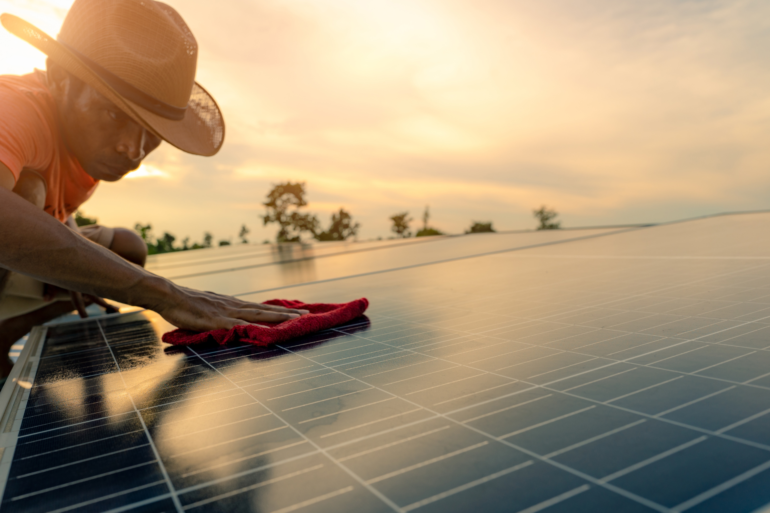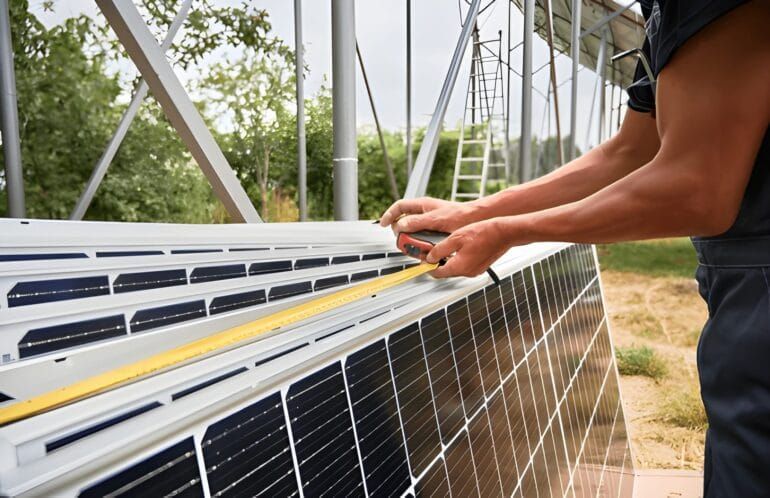Introduction
Understanding and implementing best practices in solar panel cleaning is fundamental to achieving optimal results. Soft brushes, squeegees, and mild detergents stand out as essential tools in ensuring a thorough yet gentle cleaning process. Timing also plays a crucial role, with early morning or late afternoon cleaning sessions recommended to avoid the heat of the day and ensure proper drying, minimizing the risk of streaking.
The Basics of Solar Panels
Before delving into the importance of cleaning, it’s essential to understand how solar panels work. Solar panels harness sunlight and convert it into electricity through the photovoltaic effect. Photovoltaic cells, typically made of silicon, generate an electric current when exposed to sunlight. This generated electricity is then used to power homes, businesses, and even entire grids. However, for solar panels to operate at peak efficiency, they need to receive an optimal amount of sunlight.
The Accumulation of Dirt and Debris
Solar panels are typically installed outdoors, exposed to the elements. Over time, they can accumulate dirt, dust, pollen, bird droppings, and other debris. This buildup can create a layer on the surface of the panels, hindering the penetration of sunlight. As a result, the efficiency of the solar panels decreases, leading to a reduction in electricity generation.
Effects of Dirty Solar Panels
Reduced Energy Production: The primary purpose of solar panels is to convert sunlight into electricity. When the panels are covered in dirt, their ability to capture sunlight diminishes, resulting in decreased energy production.
Impact on Return on Investment (ROI): Solar panel installations are a significant investment. Regular cleaning ensures that you get the most out of your investment by maximizing energy production and, subsequently, your return on investment.
Long-Term Damage: Prolonged exposure to dirt and debris can cause damage to the solar panels. Scratches and stains may occur, impacting the structural integrity of the panels and potentially leading to more significant issues over time.
Aesthetic Concerns: Clean solar panels not only function more efficiently but also look more appealing. This is especially relevant for residential solar installations where aesthetics play a role in the overall appeal of the property.
The Importance of Regular Cleaning
Optimizing Energy Output: Regular cleaning ensures that solar panels receive the maximum amount of sunlight, optimizing their energy output. This is particularly crucial in regions with sporadic rainfall or high levels of airborne pollutants.
Maintaining Peak Performance: Clean solar panels operate at their maximum efficiency, ensuring that the photovoltaic cells can convert sunlight into electricity without hindrance. This is essential for meeting energy demands and achieving the desired performance from the solar energy system.
Extending Lifespan: Proper maintenance, including regular cleaning, can extend the lifespan of solar panels. By preventing damage from dirt and debris, panels are more likely to function effectively for their expected lifespan, providing clean energy for years to come.
Cost Savings: While it may seem like an additional expense, investing in regular solar panel cleaning can result in long-term cost savings. The increased energy production offsets the cleaning costs and helps in maximizing the overall efficiency of the solar energy system.
Best Practices for Solar Panel Cleaning
Frequency: The frequency of cleaning depends on factors such as local climate, the presence of pollutants, and the tilt angle of the solar panels. In areas with more dust or pollen, more frequent cleaning may be necessary.
Time of Day: Cleaning is most effective when done early in the morning or late in the afternoon.
 Cleaning during these times helps to avoid the heat of the day, preventing water from evaporating quickly and leaving streaks.
Cleaning during these times helps to avoid the heat of the day, preventing water from evaporating quickly and leaving streaks.
Use of Proper Tools: Soft brushes, squeegees, and a gentle detergent are recommended for cleaning solar panels. Harsh abrasives or high-pressure water should be avoided, as they can cause damage to the panels.
Professional Cleaning Services: For large-scale solar installations or difficult-to-reach panels, considering professional cleaning services may be a practical option. These services often use specialized equipment and have the expertise to clean panels safely and effectively.
The Role of Technological Advancements in Solar Panel Maintenance
As the demand for solar energy continues to rise, the solar industry has witnessed significant advancements not only in solar panel technology but also in the methods employed for their maintenance. These technological innovations aim to streamline the cleaning process, making it more efficient, cost-effective, and sustainable.
Automated Cleaning Systems: Recent years have seen the emergence of automated cleaning systems designed specifically for solar panels. These systems use robotic devices equipped with soft brushes and sensors to navigate and clean the panels efficiently. With the ability to operate autonomously, these robots ensure that every inch of the solar panel surface is cleaned thoroughly, reducing the need for manual intervention.
Self-Cleaning Coatings: Researchers and engineers have been working on developing self-cleaning coatings for solar panels. These coatings utilize hydrophobic materials that repel water and prevent the accumulation of dirt and debris. When rainwater comes into contact with the coated surface, it easily washes away contaminants, keeping the panels clean without the need for additional cleaning efforts.
Drones for Inspection and Cleaning: Drones equipped with cameras and cleaning mechanisms have become valuable tools for inspecting and cleaning solar panels in large installations. They provide a bird’s-eye view of the entire solar array, allowing for quick identification of dirty or damaged panels. Drones can also carry out cleaning operations efficiently, reaching areas that may be challenging for manual cleaning methods.
Real-time Monitoring Systems: Advancements in sensor technology and data analytics have led to the development of real-time monitoring systems for solar panels. These systems continuously collect data on the performance of each panel, including factors such as energy output and temperature. By analyzing this data, maintenance teams can identify underperforming panels or those in need of cleaning, allowing for targeted and timely interventions.
Machine Learning Algorithms: Machine learning algorithms are being integrated into solar panel maintenance practices to predict the optimal times for cleaning based on weather patterns, pollution levels, and historical performance data. By leveraging predictive analytics, these algorithms can recommend the most effective cleaning schedule, minimizing downtime and maximizing energy production.
Remote Maintenance and Diagnostics: The integration of Internet of Things (IoT) technology allows for remote monitoring and diagnostics of solar panels. Maintenance teams can access real-time data from the panels, enabling them to identify issues, schedule cleanings, and perform necessary repairs without physically being on-site. This not only enhances efficiency but also reduces the logistical challenges associated with manual maintenance.
Conclusion
In the pursuit of a sustainable energy future, the efficiency and longevity of solar panels play a pivotal role. Regular cleaning is a simple yet effective measure to ensure that solar panels operate at their optimal capacity. By investing in maintenance practices such as cleaning, we can maximize energy production, extend the lifespan of solar panels, and contribute to a cleaner, greener planet. As the world continues to embrace renewable energy, let us not overlook the importance of keeping our solar panels shining bright.







